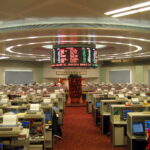Trump has continued to claim that the tariffs he imposes on foreign countries, which are unprecedented in their scope, will bring American manufacturing back to America.
A recent CNBC study suggests that there are still several obstacles to onshoring of supply chains by American companies.
US stocks recovered some lost ground during recent sessions, after the White House decided to take a 90 day pause from almost all of its reciprocal duties except for those it imposed on China.
The benchmark S&P 500 is still down by nearly 15% from its current year to date.
Costs of manufacturing in the US are significantly higher
Over half of the respondents to CNBC’s survey believe that US companies will face astronomical costs should they move production onshore.
Companies will actually prefer to move their supply chains out of the US to countries with lower tariffs, as bringing them back to the US would double the price to make products.
They added that relocating the production to countries with lower tariffs will be much cheaper.
Trump’s trade tariffs are likely to cause China to lose its manufacturing leadership.
According to a new CNBC Supply Chain Survey, the US will not benefit from the opposite end.
What else is the reason for companies manufacturing outside the US?
The difficulty of finding skilled workers was another top reason why companies may choose not to relocate their production in the US following the Trump tariffs.
Apple’s chief executive Tim Cook said that a gathering of Chinese tooling engineers could cover several football fields.
It may even not fill an entire room in the US.
Cook said in an interview with the Washington Post last year that “the expertise of Chinese workers in vocational fields is extremely deep”.
The tax leniency alone is not enough to encourage onshore production
The President has pledged significant tax leniency for businesses that agree to onshore their supply chains.
CNBC’s survey participants said that the benefits of taxation are insufficient to compensate for the higher cost of production at home.
The majority of survey respondents said that Trump’s trade policies were more “bullying” towards corporate America.
The experts are worried that the tariffs may trigger a war of trade this year, and plunge the US into recession by the second half 2025.
In recent weeks, several Wall Street analysts have lowered their S&P 500 year-end target prices.
Bank of America lowered last week its target for the S&P 500 at year’s end to 5,600. This indicates a potential gain of only 3.0%.
The post Can tariffs bring back manufacturing to the US really? This post Will tariffs really bring manufacturing back to the US?






